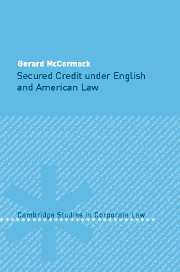Book contents
- Frontmatter
- Contents
- Preface
- List of abbreviations
- 1 The essence and importance of security
- 2 Security rights under English law
- 3 An overview of Article 9 of the Uniform Commercial Code
- 4 Implications of Article 9-type reforms for the English law of security interests
- 5 Notice filing versus transaction filing
- 6 Retention-of-title clauses under English law and Article 9
- 7 Receivables financing
- 8 Security interests in deposit accounts, investment property and insurance policies
- Appendix: Article 9 of the Uniform Commercial Code
- Index
5 - Notice filing versus transaction filing
Published online by Cambridge University Press: 23 July 2009
- Frontmatter
- Contents
- Preface
- List of abbreviations
- 1 The essence and importance of security
- 2 Security rights under English law
- 3 An overview of Article 9 of the Uniform Commercial Code
- 4 Implications of Article 9-type reforms for the English law of security interests
- 5 Notice filing versus transaction filing
- 6 Retention-of-title clauses under English law and Article 9
- 7 Receivables financing
- 8 Security interests in deposit accounts, investment property and insurance policies
- Appendix: Article 9 of the Uniform Commercial Code
- Index
Summary
The Company Law Review Steering Group in its final report, Modern Company Law for a Competitive Economy, suggested that the law relating to registration of company charges is of real importance to the capital markets as it guards against fraud and facilitates commercial borrowing. The Law Commission endorsed this conclusion and suggested that the system performs a useful commercial function. In its view, it was a means of providing information on the financial position of companies that the business community and its professional advisers find important and helpful. Both bodies, however, provisionally concluded that the present system was open to substantial criticism and should be replaced with a system based on the ‘notice-filing’ model employed in the US under Article 9 of the UCC and in Canada and New Zealand under PPSA statutes. Most types of security interest created by corporate borrowers in England require registration in order to ensure validity of the security interest in the event of the borrower going into liquidation or administration. The list of registrable charges is set out in Part 12 Companies Act 1985. The position is broadly similar in the US though there the registration or filing obligation applies to a broader range of security interests. This chapter will examine the mechanics of the registration system in England and compare it with notice filing under Article 9.
- Type
- Chapter
- Information
- Secured Credit under English and American Law , pp. 129 - 162Publisher: Cambridge University PressPrint publication year: 2004



